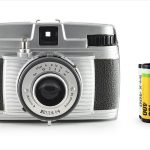Bilora Bella 44 Specifications
| Manufacturer: | Kürbi & Niggeloh |
| Origin: | West Germany |
| (modern day Germany) | |
| Made in: | Radevormwald, West Germany |
| (modern day Germany) | |
| Introduced: | 1958 |
| Type: | Viewfinder |
| Format: | 127 Film |
| Dimensions: | 12.4 x 8.1 x 7 cm |
Bilora Bella 44 Overview
The Bilora Bella 44 is a viewfinder camera introduced in 1958 under the brand name Bilora by Kürbi & Niggeloh, a manufacturer based in the German town of Radevormwald some 40 kilometers west of Düsseldorf. So named because it produced 4x4cm exposures, the Bella 44 was very similar to the original Bella of 1953 and the Bella 46, both of which delivered 4x6cm negatives. During its production life, the Bella 44 was also sold in the US as the Tower No. 5 and the Ansco Lancer as well as in Germany as the Foto-Quelle Revue 44.
Focusing the Bella 44’s Achromat f/8 lens is done by rotating the ring immediately surrounding the front element. Only two aperture settings are available (f/8 and f/16) and can be chosen via a switch at eight o’clock on the lens barrel while shutter speeds (1/100, 1/50, and Bulb) are selected at 12. A flash sync post is found at two o’clock while the threaded shutter button is located at 11. The film advance knob is just beneath the top plate which houses only a cold shoe. The latch that holds the back of the camera on can be found in the middle below the viewfinder and above the red window. The only thing on the camera’s bottom plate is a tripod socket.
I purchased this particular Bella 44 via an eBay auction after falling in love with its beautiful, Art Deco-esque styling. I love its tasteful grey leatherette and even the two tiny triangle-shaped dimples on the back (although I’m not sure what their function is, if any). It doesn’t seem particularly German to me that the Bella 44 makes up in charm what it lacks in sophistication, but I don’t really care.
Find your very own Bilora Bella 44 on eBay.
McKeown, James M. and Joan C. McKeown’s Price Guide to Antique and Classic Cameras, 2001-2002. (Grantsburg, WI, USA: Centennial Photo Service, 2001), p 53, 96, 604.


















